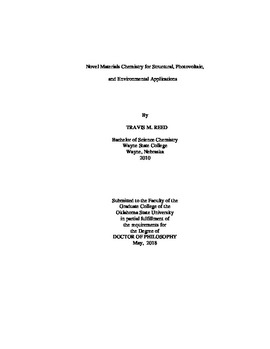| dc.contributor.advisor | Apblett, Allen | |
| dc.contributor.author | Reed, Travis M. | |
| dc.date.accessioned | 2018-12-11T22:09:46Z | |
| dc.date.available | 2018-12-11T22:09:46Z | |
| dc.date.issued | 2018-05 | |
| dc.identifier.uri | https://hdl.handle.net/11244/316318 | |
| dc.description.abstract | Alkali-silica reaction (ASR) causes the untimely degradation of concrete structures such as bridges, dams, and roadways. This reaction occurs due to the alkalis present in the cement and the reactive forms of silica found in the aggregates used in concrete production. Neutralization of these reactive aggregates was done by a pretreatments using LiOH or Ca(OH)2 to the aggregates. The pretreated aggregates showed a significant reduction in expansion during the ASTM C 1260 standardized test leading to the elimination of ASR. | |
| dc.description.abstract | Additionally, the synthesis of bimetallic metal oxides were investigated for the use in arsenic remediation from aqueous media, as well as, for materials for potential photovoltaic applications. The synthesis of bimetallic pyruvic acid oxime precursors provides a low temperature decomposing single source precursors for the corresponding metal oxides. Controlling the stoichiometry of the metal salts in the precursor synthesis allows for retention of the desired stoichiometry in the final bimetallic metal oxide. Several Iron/zinc metal oxides of various stoichiometry were synthesized, characterized, and then used to treat arsenate (H2AsO4- and HAsO42-) and arsenite (H3AsO3) aqueous solutions. Maximum capacities were determined by using both Langmuir and Freundlich adsorption isotherm models. Real world samples were investigated to examine samples with a more diverse matrix. These samples covered industrial wastewaters, ground water, and apple juice. In all treatments, the arsenic concentration was reduced to below the detection limit of the microwave plasma atomic emission spectroscopy. The other bimetallic metal oxide system investigated was cobalt-doped zinc oxide for potential use in photovoltaic applications. ZnO is a wideband gap semiconductor that absorbs light in the near ultraviolet region, but when doped with cobalt, the material is red shifted and absorbs light in the red wavelength range. The control of the stoichiometry allowed for the doping of ZnO with 5% and 10% cobalt through the decomposition of the pyruvic acid oxime precursors. Cobalt-doped ZnO was also synthesized in various doping percentages by a chemical bath method, which allows for growth of a film onto a glass slide. Films initially produced layered hydroxy salts that are easily converted to doped ZnO around 200°C. | |
| dc.format | application/pdf | |
| dc.language | en_US | |
| dc.rights | Copyright is held by the author who has granted the Oklahoma State University Library the non-exclusive right to share this material in its institutional repository. Contact Digital Library Services at lib-dls@okstate.edu or 405-744-9161 for the permission policy on the use, reproduction or distribution of this material. | |
| dc.title | Novel materials chemistry for structural, photovoltaic, and environmental applications | |
| dc.contributor.committeeMember | Materer, Nicholas | |
| dc.contributor.committeeMember | Weinert, Charles S. | |
| dc.contributor.committeeMember | Blum, Frank D. | |
| dc.contributor.committeeMember | Ley, Tyler | |
| osu.filename | Reed_okstate_0664D_15656.pdf | |
| osu.accesstype | Open Access | |
| dc.type.genre | Dissertation | |
| dc.type.material | Text | |
| thesis.degree.discipline | Chemistry | |
| thesis.degree.grantor | Oklahoma State University | |
